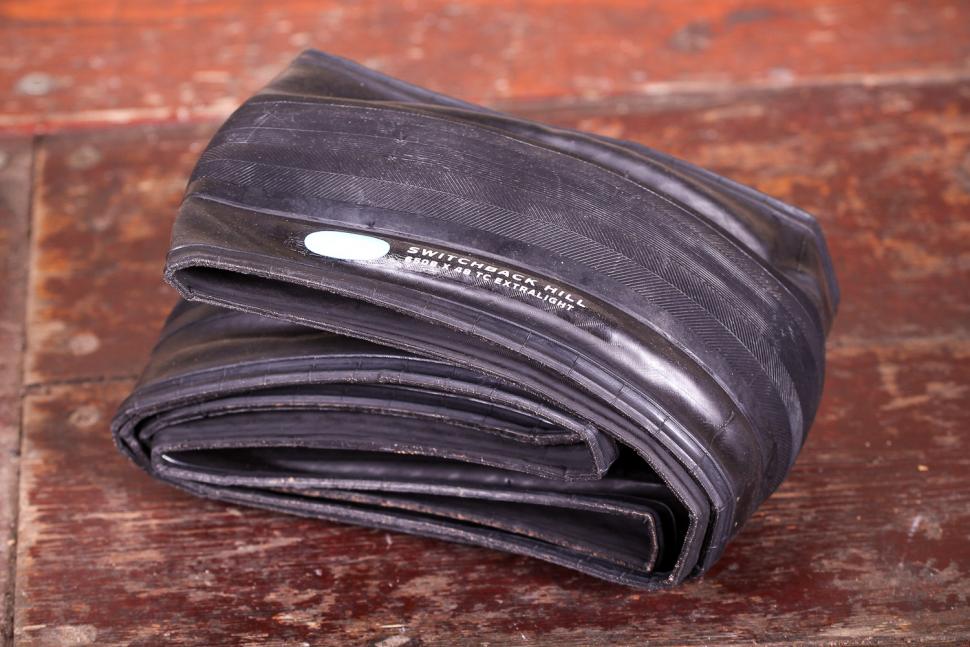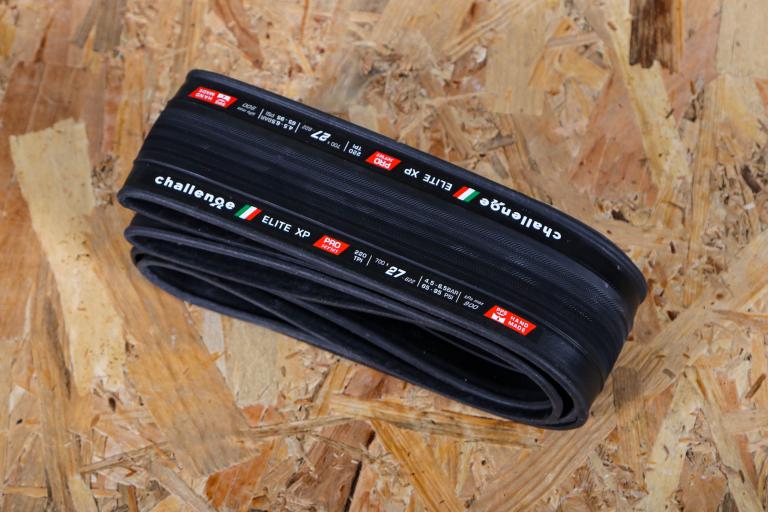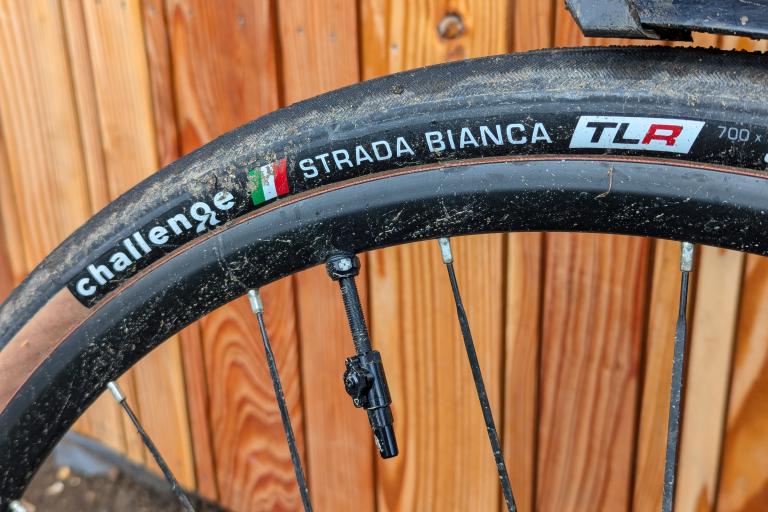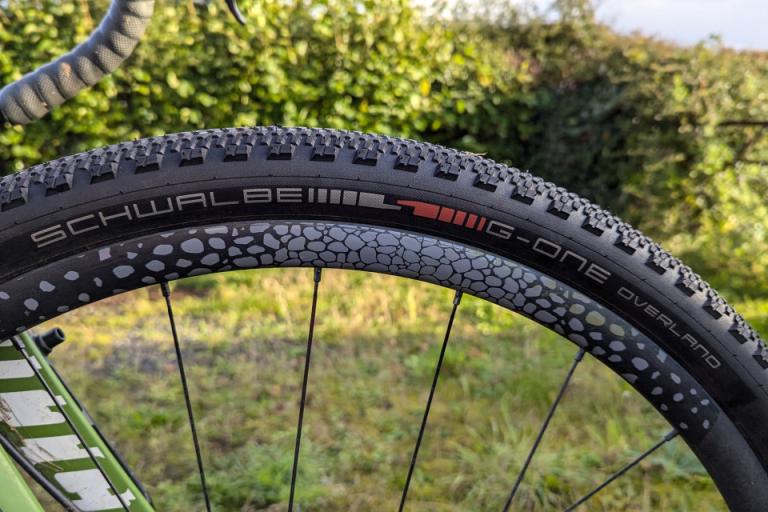- News
- Reviews
- Bikes
- Components
- Bar tape & grips
- Bottom brackets
- Brake & gear cables
- Brake & STI levers
- Brake pads & spares
- Brakes
- Cassettes & freewheels
- Chains
- Chainsets & chainrings
- Derailleurs - front
- Derailleurs - rear
- Forks
- Gear levers & shifters
- Groupsets
- Handlebars & extensions
- Headsets
- Hubs
- Inner tubes
- Pedals
- Quick releases & skewers
- Saddles
- Seatposts
- Stems
- Wheels
- Tyres
- Tubeless valves
- Accessories
- Accessories - misc
- Computer mounts
- Bags
- Bar ends
- Bike bags & cases
- Bottle cages
- Bottles
- Cameras
- Car racks
- Child seats
- Computers
- Glasses
- GPS units
- Helmets
- Lights - front
- Lights - rear
- Lights - sets
- Locks
- Mirrors
- Mudguards
- Racks
- Pumps & CO2 inflators
- Puncture kits
- Reflectives
- Smart watches
- Stands and racks
- Trailers
- Clothing
- Health, fitness and nutrition
- Tools and workshop
- Miscellaneous
- Buyers Guides
- Features
- Forum
- Recommends
- Podcast
review
 Compass 650B x 48 Switchback Hill Extralight TC tyre folded on wooden surface
Compass 650B x 48 Switchback Hill Extralight TC tyre folded on wooden surface£73.00
VERDICT:
Exceptional, super-light, big chamber tyres that roll fast on tarmac and gravel alike
Weight:
412g
Contact:
At road.cc every product is thoroughly tested for as long as it takes to get a proper insight into how well it works. Our reviewers are experienced cyclists that we trust to be objective. While we strive to ensure that opinions expressed are backed up by facts, reviews are by their nature an informed opinion, not a definitive verdict. We don't intentionally try to break anything (except locks) but we do try to look for weak points in any design. The overall score is not just an average of the other scores: it reflects both a product's function and value – with value determined by how a product compares with items of similar spec, quality, and price.
What the road.cc scores meanGood scores are more common than bad, because fortunately good products are more common than bad.
- Exceptional
- Excellent
- Very Good
- Good
- Quite good
- Average
- Not so good
- Poor
- Bad
- Appalling
How wide is too wide? The 48mm Switchback Hill is the widest 650B tyre that Compass makes, and too wide it ain't. It's super-comfortable, fast-rolling, tubeless-compatible, off-road-capable and light. There's really not a lot wrong here. At a time when people are doing roll-down tests to see if it's worth switching to 28mm tyres from 25s, my advice would be to skip a few sizes and fit a pair of these, if you can. They're great.
- Pros: Light; fast; comfortable
- Cons: Tricky to set up; you'll need the clearance to fit them
Compass has all its tyres made in Japan by Panaracer to its own specifications. I've heard plenty of times that these tyres are just 'rebadged Panaracers'; they're not, although they do share the same facility. The Switchback Hill is a 48mm, 650b road/gravel tyre that's available in a standard or an extralight carcass (the one that we have) that saves 65g.
Our test tyres weighed in at 412g either end, which is very light for such a big tyre; lighter indeed than the 40mm Schwalbe G-One Speed tyres that I swapped them out for.
Fitting the Switchback Hill tyres tubeless isn't hard exactly, but it did require a specific workflow to make them seal. If you bung them on the rim and just try to blast them on with a tyre booster or a compressor, you'll be out of luck. Well, I was anyway. In the end I removed the tubeless valve, fitted an inner tube, pumped them up nice and hard to pop both beads in the rim, deflated them, unhooked one bead, removed the tube, fitted the valve and then used an Airshot to pop the unhooked bead back on. Et la.
If that sounds like a massive faff then yes, it's a more drawn-out process than fitting the G-One Speeds that they replaced which you can bung on with a track pump, but those are a bit heavier and more rigid, and keep their shape better when deflated. The carcass of the Switchback Hills – these are the Extralight ones, after all – is a lot more flexible and doesn't pop out to the bead on its own. Anyway, bottom line: you need an hour, but it's not hard.
> Buyer's Guide: Tubeless tyres
I was fitting them to a set of the excellent Reynolds ATR 650b wheels, and I stuck them on my first-generation Tripster ATR. That's as big a tyre as that frame will take; there's about 2mm of grace either side. Most modern gravel bikes will squeeze them in. More road-orientated adventure bikes will struggle.
Once they were up, they went down. The first time, anyway; that was because I was a bit stingy with the sealant. I needed 60ml in each tyre (I used Orange Seal, which is what Compass recommends) to make them stay up. You need to use latex sealant as they don't have a buytl liner; the lack of a liner is what makes the carcass of the tyre so light and flexible, but it's not airtight off the production line and the sealant needs to find all the little holes. The best thing to do is get the bike in a workstand and keep spinning the wheels from time to time to slosh the sealant around.
With an eye-watering 40psi in the Switchback Hills it was time to take them out on the open road. And what lovely tyres they are. I've completed plenty of riding on the Switchback Hills, including a 300km weekend to and from North Devon on a Sven Pathfinder (with lightweight tubes), and lots of shorter rides on my Tripster ATR around Bath (running tubeless).
They're massive, and they only weigh 412g a piece; the extralight casing is super supple and they thrum along on tarmac with no obvious penalty over something much, much narrower. I've checked my Strava times; that's not conclusive, but there's no trend to suggest I'm slower, and they don't ever feel slower. They really are quick, these tyres. Compared to the same bike, on the same routes, with 'wide' 30mm Schwalbe G-One Speed tyres, I can't discern any meaningful difference. I'm a bit quicker on my race bike (on 28s), but that's my race bike. It's 3kg lighter.
> Buyer's Guide: 27 of the best road cycling tyres
Take this ride for example: going fairly hard up a 10-minute back-lane climb I was only half a minute off my best time, and that was set on my race bike in a group, rather than on my Tripster, on my own. Further into the ride I bagged fifth overall on a short, punchy fire road climb, for which the prerequisite for a good time is basically to be able to carry plenty of speed on the preceding gravel descent. The Switchback Hills are exceptional at that.
Compass doesn't recommend the tyre for 'truly technical terrain' and indeed I'd be wary of chucking the thin sidewalls at anything that was especially rocky, but on gravelly unsurfaced paths they're almost as quick as they are on the tarmac, floating over imperfections with aplomb, especially if you drop the pressure a bit.
On the road they allow you to be a lot less choosy with your line, and in a group you have to remember to point out holes and other imperfections that you can glide over on 48s but might easily pinch-flat a 25. Grip is exceptional, with the tyres deforming around imperfections and hugging the tarmac on steep climbs and tricky descents.
They really come into their own on any surface that's less than smooth; that can be gravelly back lanes or a main road with a surface in need of repair. Basically, round here, it translates as: nearly any road.
Those are the main reasons to fit a tyre like this: versatility over a range of surfaces, grip, and comfort. Compass recommends a maximum pressure of 55psi. My sweetspot was about 38 in the front tyre and 40 in the rear; I'm about 92kg so lighter riders will be going lower. That's a bit above what the all-knowing Berto chart of tyre width vs. optimal pressure would suggest is ideal for a 15% compression of the tyre (36/28psi), but it felt good to me on a bike that's predominantly used on the road.
> How to choose your tyre pressure
Overall, I'm really impressed with the Switchback Hills, as you can tell. We've tested the Steliacoom TC and the Barlow Pass TC previously, and both of those tyres received high praise from reviewer Mike Stead and these are no different. Aside from the fact that they're a bit of a pain to fit, there really is no downside to a big tyre like this if you're doing anything other than racing.
Verdict
Exceptional, super-light, big chamber tyres that roll fast on tarmac and gravel alike
road.cc test report
Make and model: Compass 650B x 48 Switchback Hill Extralight TC
Size tested: 48mm wide
Tell us what the product is for
Compass says, "At 48 mm wide, the Switchback Hill is our largest 650B (27.5') tire yet. Switchback Hill is the first and only named climb on the 360 mile Oregon Outback gravel ride/race. The gravel is quite loose in places, and the extra floatation of the Switchback Hill tires gives you more speed and security when the going gets really rough.
30% of the Oregon Outback is on pavement, so we designed this tire to roll as fast and grip as well as a good racing tire. With this tire, you truly have the best of both worlds.
The Switchback Hill also can transform the performance of your 27.5' mountain bike on gravel or paved roads. However, it is not intended for truly technical terrain, and with its supple sidewalls, it will not climb out of ruts like a stiff mountain bike tire.
The Switchback Hill is tubeless-compatible in both standard and extralight casings. When used with tubes, we recommend the SV13 or SV14A tubes."
Tell us some more about the technical aspects of the product?
From Compass:
Standard model
Clincher, folding bead
Tubeless-compatible
Ultra-light, ultra-supple casing
Choice of black or tan sidewalls
Further improved comfort
Ultra-low rolling resistance
Excellent grip
Superior comfort
Light weight
Classic appearance
Clincher tires with the ride of a good tubular
Maximum pressure with tubes: 55 psi (3.8 bar)
Maximum recommended pressure – tubeless: 55 psi (3.8 bar)
413 g
Rate the product for quality of construction:
8/10
Slight wobble in the carcass around the seam on one of the tyres, otherwise all fine.
Rate the product for performance:
10/10
Yes to big tyres. Fast, light and comfy.
Rate the product for durability:
7/10
Holding up well. They are a very thin carcass, so I wouldn't expect them to last forever, but there's plenty of tread and they're wearing well.
Rate the product for weight (if applicable)
8/10
412g for a 48mm tyre is pretty impressive.
Rate the product for comfort (if applicable)
10/10
They are super comfy. The comfiest tyres.
Rate the product for value:
7/10
They're pretty expensive, but they're good value considering the performance.
Tell us how the product performed overall when used for its designed purpose
They're exceptional.
Tell us what you particularly liked about the product
Fast, light and comfy.
Tell us what you particularly disliked about the product
They're a bit of a faff to run tubeless.
Did you enjoy using the product? Yes
Would you consider buying the product? Yes
Would you recommend the product to a friend? If they had a frame with enough clearance, definitely yes.
Use this box to explain your overall score
Gosh what lovely tyres these are. You get a few funny looks from the roadies but you'll be able to keep up just fine...
About the tester
Age: 44
I usually ride: whatever I'm testing... My best bike is: Kinesis Tripster ATR, Kinesis Aithein
I've been riding for: Over 20 years I ride: Every day I would class myself as: Experienced
I regularly do the following types of riding: road racing, time trialling, cyclo-cross, commuting, club rides, sportives, general fitness riding, fixed/singlespeed, mountain biking, Mountain Bike Bog Snorkelling, track
Dave is a founding father of road.cc, having previously worked on Cycling Plus and What Mountain Bike magazines back in the day. He also writes about e-bikes for our sister publication ebiketips. He's won three mountain bike bog snorkelling World Championships, and races at the back of the third cats.
Latest Comments
- NPlus1Bikelights 3 hours 16 min ago
We've saved them multiple times with Kick Starters. Shame. Edit: tense.
- NPlus1Bikelights 3 hours 19 min ago
Or the congregation reads the news and does not like all the stories about ignored abuse by senior members of the church.
- NPlus1Bikelights 3 hours 21 min ago
Kask remains sexier. And their prices, whilst high, are not as over the top as these.
- rookybiker 3 hours 43 min ago
> Are the ASO, basically saying it didn't happen The authority is the UCI. ASO was only the race organiser.
- Simon Withers 4 hours 11 min ago
At the moment the Triban RC520 Disc is £899.99 - and it's a very good bike (I've ridden it and recommended it in the past). ...
- Miller 4 hours 15 min ago
I remember this being released and thinking it was definitely the future. I built my own kludgy, much cheaper equivalent in 2013....
- brooksby 4 hours 55 min ago
I have a Grand Prix appointment next week anyway, so I may decide to discuss this with them instead of what I'd booked it for...
- David9694 4 hours 57 min ago
Come with me to Brockenhurst, New Forest. It has a train station and a bike shop and in the summer season the area attracts visitors, many of whom...
- brooksby 6 hours 57 min ago
Clevedon seafront "cycle lane" at the weekend... All those empty cars can finally park facing the sea again




Add new comment
8 comments
Keep in mind the Extra Light version means the casing is extra supple. It's also lighter but you choose it because it's made of a more supple casing fabric. This is the reason for the fairly low max. pressure rating. Having ridden both the regular and Extra Light casing versions of several Compass tires, I can report you do notice the difference in speed and rolling ease for the Extra Light versions.
Wider Tyres = Faster over rough surfaces, better offroad, more comfort, longer service life, better puncture resistance, and better grip (particularly noticeable in the wet).
I do like my Schwalbe 40mm G Ones, they are fast and comfy. I can use them for most events. There is a small price to pay in a little extra drag, either friction or air resistance with big tyres, I tend to get dropped from club rides a little earlier due to this compared to my 25mm aero wheels
I started using a Corretec Easy 700x40 with reasonably wide 100g butyl tubes, the tyre itself is 328g so in the extremely light bracket for its size.
Personally I didn't find it faster on a loop, similar conditions (next to zero wind on 25C day) than 28s, I'm not alone in finding that really wide tyres are not faster on road in real world use, there may well be a bit more comfort over say a 28mm tyre on longer journeys but having used folding 42mm & 32mm 700C tyres for a few years previously (and still use 32mm on my daily) for various tasks/rides I've just not found them to be faster.
I also think you're comparing a bit of apples with oranges, you'd surely have to ride on a pair of similarly high end tyres if not exactly the same tyre only in a narrower version and ride over same course/same day using a watt meter to have any accuracy whatsoever in comparing speeds/how fast they are.
Off road I'll grant you a wider tyre is going to be far more beneficial in most situations but jumping straight to a 48, I dunno about that, it won't be for everyone for all occasions, then as mentioned unless you have the frame for it you're going to have to take narrower variants.
I just wish that manufacturers could have expanded the range/choices of the existing 559/571 sizes plus tyres so that we don't have to buy a completely new bike to find out what all the fuss is about, but then that wouldn't be very good marketing would it
Oh and £73, I know good tyres don't come cheap but still £73, the Corretec's I bought are £15 each!
I don't think (m)any people are claiming that wide tires of say 32c+ are faster than the traditonal 23/25/28c it's just that you can gain alot of comfort and versatility without much (if any) tangible loss of speed.
No-one was here for sure, I think it's just got to the point of Pavlovian response. It's similar with the lack of understanding about the current availability and choice of 27.5" tyres, rims and wheelsets vs 26", let alone the issues like OD - or that the surprise that price of some old stock tyre, for which there isn't much demand at the moment, may be slightly different from the full RRP of a brand new (quite top-end) one in a more supported format. Hey ho.
Yeah, i'm not really saying they're faster. I'm just saying, that for similar riding at a similar effort level, they don't feel noticeably slower and the non-scientific/peer-reviewed/double-blind-controlled strava data suggests that they're not. What they are is really comfortable and grippy over a much wider range of surfaces.
for a lot of the riding I do they're probably overkill; i reckon a fast 700x40 is more likely the sweet spot for me. i have some compass extralight 700x38s up for testing next. i may do a more controlled test of the two.
An excellent review that really highlights the reasons behind moving to bigger tires and less pressure. I am convinced, but i have been fpr a while; try convincing all the traditionalist roadies, thats another thing...